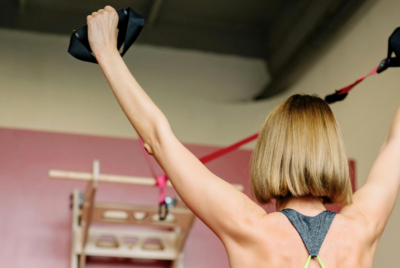Upper Back Exercises: Strengthen Your Back for Better Posture and Pain Relief
When was the last time you really focused on your upper back? We often emphasize working on our arms, legs, or abs but tend to overlook the upper back, which is crucial for posture and overall upper body strength. Trust me, as someone who has experienced everything from back pain under the shoulder blade to stiffness between the shoulder blades, I now realize the importance of a strong upper back. Strengthening these muscles can make a world of difference, especially when it comes to preventing pain, improving posture, and supporting other physical activities. In this article, I’ll guide you through various upper back exercises that are great for building strength and mobility, while also offering recommendations and tips to help you integrate these moves into your fitness routine.
Understanding the Upper Back Muscles

The upper back consists of several important muscle groups that are responsible for maintaining posture, supporting your shoulders, and assisting in movements like pulling and lifting. Key muscles include the trapezius, rhomboids, and latissimus dorsi. These muscles often go unnoticed until you feel pain in the upper back between shoulder blades or struggle with mobility. Neglecting these muscles can lead to upper back pain between the shoulder blades and chest, back pain under the right shoulder blade, and even chronic pain issues.
Expanding the understanding of the upper back muscles helps target exercises more effectively. Here are five more muscles and movements you should know:
1. Infraspinatus – Supports shoulder stability and prevents injury during overhead movements.
2. Teres Major – Assists in movements like arm adduction and internal rotation.
3. Posterior Deltoid – The rear deltoid is crucial for arm movement and upper back strength.
4. Erector Spinae – Helps in maintaining proper posture and spinal extension.
5. Serratus Posterior Superior – Assists in lifting the ribs, aiding in breathing and posture.
Understanding the functionality of each muscle group is key to performing effective upper back exercises. Without proper activation, these muscles can cause pain in the upper back left side under the shoulder blade or even burning upper back pain between shoulder blades during daily activities.
Benefits of Upper Back Exercises
Upper back exercises do more than just build muscle—they can significantly improve your daily life by enhancing posture, reducing pain, and strengthening your overall body. I remember waking up with upper back pain between the shoulder blades after hours of poor posture at my desk job. After consistently performing upper back exercises, that pain has become a distant memory.
Here are five major benefits of focusing on upper back exercises:
1. Posture Improvement – Strengthening these muscles pulls your shoulders back and aligns your spine, preventing the rounded back look that leads to pain.
2. Pain Relief – Strengthening your upper back can reduce pain in the upper back right side under the shoulder blade and alleviate back pain near the shoulder blade caused by slouching or hunching.
3. Increased Mobility – A strong upper back helps with overall mobility, allowing you to perform daily tasks or workouts with ease and reducing back pain by the shoulder blade.
4. Balanced Strength – Your upper back supports many other movements, such as pulling or pushing, so strengthening it balances out your total body strength.
5. Reduced Risk of Injury – A strong upper back reduces the likelihood of injuries, such as strains or sprains, especially if you regularly lift weights or perform strenuous physical tasks.
Preparing for Upper Back Exercises

Warm-up Essentials
Before jumping into upper back exercises, it’s important to warm up properly. A few years ago, I started skipping my warm-ups, and soon enough, I ended up with back pain under the left shoulder blade. This taught me the value of a good warm-up, particularly when working on the upper back.
Here’s a solid warm-up routine to follow before upper back exercises:
1. Arm Circles – Loosen up the shoulder joints with small and large circles.
2. Shoulder Rolls – Roll your shoulders forward and backward to engage the upper back muscles.
3. Dynamic Stretching – Reach your arms overhead, across the body, and behind to stretch the upper back.
4. Resistance Band Pull-Aparts – Using a light resistance band, pull the band apart in front of you to activate the shoulder blades and trapezius.
5. Cat-Cow Stretch – A yoga stretch that loosens up your spine and warms up your back muscles.
Taking 5–10 minutes for a proper warm-up not only prevents injuries but also ensures you’re engaging the correct muscles during the workout.
Top Upper Back Exercises for Strength and Posture
1. Bent-Over Rows
Bent-over rows are one of the best exercises for building overall upper back strength. By targeting the latissimus dorsi and rhomboids, this move helps improve posture and reduce back pain under the shoulder blade’s left side.
How to Perform:
1. Grab a pair of dumbbells.
2. Bend slightly at your waist, keeping your back flat.
3. Pull the dumbbells towards your waist, focusing on squeezing your shoulder blades together.
4. Lower the weights and repeat.
5 Key Recommendations for Effective Bent-Over Rows:
1. Keep your core tight to avoid arching your back.
2. Focus on the muscle contraction during the upward movement.
3. Use lighter weights until you perfect your form.
4. Perform the movement slowly to ensure proper activation.
5. Try using a barbell for variation and to hit more muscle fibers.
2. Face Pulls
Face pulls are essential for upper back health and shoulder mobility, and they can help with reducing pain in the upper back between shoulder blades relief. If you’ve ever felt that upper back pain between shoulder blades and chest, this exercise is for you.
How to Perform:
1. Attach a rope to a cable machine at face height.
2. Grab the rope with both hands and pull towards your face, keeping your elbows high.
3. Squeeze your shoulder blades together at the peak of the movement.
4. Return to the starting position and repeat.
5 Key Recommendations for Face Pulls:
1. Keep your elbows above your shoulders throughout the exercise.
2. Avoid using too much weight—focus on form.
3. Ensure the cable is set at face height for optimal muscle activation.
4. Incorporate this exercise twice a week for improved upper back mobility.
5. Use resistance bands as an alternative if you don’t have access to a cable machine.
3. Reverse Fly
The reverse fly targets the rear deltoids and rhomboids, making it perfect for those suffering from upper back pain right side under the shoulder blade. It’s a relatively simple movement, but it offers great benefits for posture and mobility.
How to Perform:
1. Grab a pair of light dumbbells.
2. Bend forward at the waist while maintaining a flat back.
3. Lift the dumbbells out to your sides, like you’re flapping your arms.
4. Lower and repeat.
5 Key Recommendations for Reverse Fly:
1. Use light weights—this exercise is about control, not heavy lifting.
2. Focus on keeping your back straight throughout the movement.
3. Squeeze your shoulder blades at the top for maximum contraction.
4. Perform the exercise slowly to avoid momentum.
5. If you feel burning upper back pain between shoulder blades, lower the weight.
4. Lat Pulldowns
Lat pulldowns primarily work the latissimus dorsi, but they also engage the upper back muscles, helping relieve pain in the upper back between shoulder blades.
How to Perform:
1. Sit at a lat pulldown machine and grab the bar with a wide grip.
2. Pull the bar down towards your chest, keeping your back straight.
3. Squeeze your shoulder blades together at the bottom of the movement.
4. Return to the starting position and repeat.
5 Key Recommendations for Lat Pulldowns:
1. Keep your back straight and avoid leaning back excessively.
2. Use a wide 2. Use a wide grip to fully engage your upper back muscles.
3. Control the bar on the way up to avoid using momentum and ensure full muscle activation.
4. Incorporate a slight pause at the bottom of the movement to increase tension.
5. Try different grips (wide, narrow, or reverse) to target different areas of the upper back.
5. Seated Cable Rows
Seated cable rows are fantastic for overall back strength, particularly for the upper back, helping to alleviate back pain under the shoulder blade left side or back pain under the right shoulder blade.
How to Perform:
1. Sit at a cable row machine and grab the handle with both hands.
2. Pull the handle towards your abdomen, squeezing your shoulder blades together.
3. Return to the starting position, keeping your back straight throughout.
4. Repeat the movement.
5 Key Recommendations for Seated Cable Rows:
1. Keep your back neutral—don’t let it round or arch.
2. Use a slow and controlled motion to fully engage the upper back muscles.
3. Avoid using your legs to initiate the movement—focus on your upper body.
4. Squeeze your shoulder blades at the top of each rep.
5. Try different attachments, like a wide-grip bar or V-handle, to vary the muscle engagement.
6. Dumbbell Shrugs
Dumbbell shrugs are perfect for isolating the trapezius muscles and preventing upper back pain between shoulder blades relief by strengthening the muscles that support your neck and upper back.
How to Perform:
1. Stand with a dumbbell in each hand, arms at your sides.
2. Shrug your shoulders up towards your ears, holding the contraction for a second.
3. Lower your shoulders and repeat.
5 Key Recommendations for Dumbbell Shrugs:
1. Avoid rotating your shoulders—this can lead to injury.
2. Focus on the upward movement—the contraction is what strengthens your traps.
3. Use lighter weights initially to perfect your form before increasing the load.
4. Hold the contraction at the top for 1–2 seconds for maximum benefit.
5. Incorporate dumbbell shrugs into your workout twice a week for best results.
7. Superman Exercise
The Superman exercise is a great bodyweight move that targets your entire posterior chain, particularly the upper back. If you’ve experienced upper right back pain under the shoulder blade, this exercise can help strengthen that area.
How to Perform:
1. Lie face down on the floor with your arms extended overhead.
2. Simultaneously lift your arms, chest, and legs off the ground, squeezing your back muscles.
3. Hold for a few seconds at the top before lowering back down.
4. Repeat the movement.
5 Key Recommendations for the Superman Exercise:
1. Focus on engaging your back muscles—don’t just lift your limbs without intention.
2. Hold the position at the top for 2–3 seconds to maximize muscle activation.
3. Keep your movements controlled to avoid straining your lower back.
4. Try variations, like alternating arm and leg lifts, to make the exercise easier or harder.
5. Incorporate this exercise into your warm-up or cool-down routine for spinal support.
Stretching After Upper Back Workouts

Stretching is crucial to maintaining flexibility and preventing back pain under the shoulder blade after an intense upper back workout. Proper stretching will help with pain in the upper back right side under the shoulder blade and promote recovery.
Key Stretches for the Upper Back:
1. Child’s Pose – Stretch your upper back by extending your arms forward while sitting back on your heels.
2. Thread the Needle – Twist your upper body as you reach one arm through the space beneath your other arm to stretch the rhomboids.
3. Cat-Cow Stretch – A yoga pose that alternates between arching and rounding your spine to loosen up the upper back muscles.
4. Wall Angels – Stand with your back against a wall and move your arms up and down like you’re making snow angels.
5. Shoulder Blade Squeeze – Sit or stand, squeezing your shoulder blades together to stretch the upper back.
Top Recommended Products
When working on upper back strength and flexibility, having the right equipment can make all the difference. Here are my top Amazon picks to support your upper back workouts:
1. TRX Suspension Trainer – Perfect for bodyweight exercises like rows and face pulls.
2. Resistance Bands – Ideal for warming up and performing face pulls without a cable machine.
3. Adjustable Dumbbells – Essential for exercises like bent-over rows and reverse flys.
4. Foam Roller – Great for rolling out muscle tension and relieving upper back pain between shoulder blades after a workout.
5. Yoga Mat – Provides comfort and support for exercises like the Superman and stretching routines.
Upper Back Exercise Tips for Beginners
If you’re just getting started with upper back exercises, take it slow. Trust me, I’ve been there, and rushing only leads to injury. Here are five tips that can help you avoid issues like back pain under the left shoulder blade or upper back pain between the shoulder blades relief.
1. Start with light weights and focus on form over lifting heavy. This will ensure that you’re targeting the right muscles.
2. Incorporate a variety of exercises to hit different muscle groups in the upper back.
3. Warm up and cool down properly to avoid straining your muscles.
4. Listen to your body—if you feel discomfort or pain, stop and reassess your form or the weight you’re using.
5. Be consistent—upper back strength takes time to develop, so stick with it.
How to Integrate Upper Back Exercises into Your Routine
Incorporating upper back exercises into your routine can be simple. Whether you’re a beginner or advanced, here’s a guide to ensure you’re working on this important area:
1. Twice a week – Dedicate at least two days to upper back training to allow your muscles time to recover.
2. Mix it up – Incorporate different exercises, such as bent-over rows one day and face pulls the next.
3. Combine with other body parts – Pair upper back exercises with lower body or core workouts for a balanced routine.
4. Progress gradually – Increase weights or reps over time to continually challenge your muscles.
5. Stay consistent – Consistency is key to seeing results and alleviating back pain under the right shoulder blade.
Conclusion

Strengthening your upper back muscles is crucial not only for better posture but also for reducing pain and enhancing mobility. Through consistent exercise, I’ve noticed a remarkable difference in my own daily comfort, particularly in reducing back pain near the shoulder blade and pain in the upper back right side under the shoulder blade. Whether you’re a fitness enthusiast or just someone trying to prevent pain, incorporating these upper back exercises will improve your overall well-being.
FAQs
1. How often should I do upper back exercises?
Aim for two to three times a week, with rest days in between to allow your muscles to recover.
2. What can I do if I feel pain in my upper back?
If you’re experiencing pain, stop exercising and focus on stretching and recovery. Consult a doctor if the pain persists.
3. Can upper back exercises help with posture?
Yes, strengthening the muscles in your upper back can improve posture by pulling your shoulders back and aligning your spine.
4. What should I do if I wake up with upper back pain between my shoulder blades?
Start with gentle stretches like child’s pose or cat-cow to alleviate stiffness. If the pain persists, consider consulting a healthcare provider.
5. What equipment do I need for upper back exercises?
You can use resistance bands, dumbbells, or even your body weight for most upper back exercises. A foam roller is also helpful for post-workout recovery.
*We may earn a commission from purchases made through our links, at no cost to you. This does not affect our product recommendations. Please see our disclosure to learn more.
![Urban Health Hive]](https://urbanhealthhive.com/wp-content/uploads/2023/05/cropped-cropped-Health_Logo.png)



